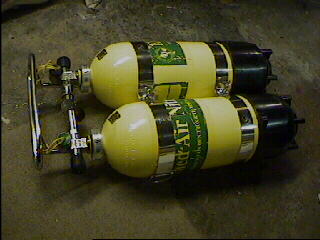


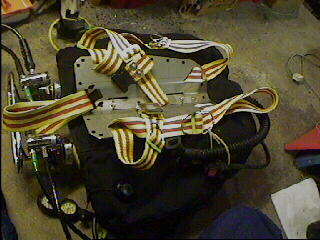
 Yes I do have a standard BCD (Scubapro Club) which carries a
single 12L 232bar tank equipped with a Scubapro Mk20 and M380 regulator/octopus
combination. I like it and for a lot of the diving that I do, eg: warm water
holidays, it is good competent kit. The equipment set-up I describe here is my
twinset rig with all sorts of personal reasons for things.
Yes I do have a standard BCD (Scubapro Club) which carries a
single 12L 232bar tank equipped with a Scubapro Mk20 and M380 regulator/octopus
combination. I like it and for a lot of the diving that I do, eg: warm water
holidays, it is good competent kit. The equipment set-up I describe here is my
twinset rig with all sorts of personal reasons for things.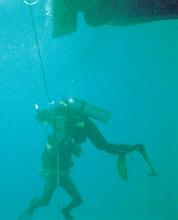 If the dive isn't safe don't dive.
If the dive isn't safe don't dive.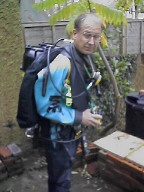
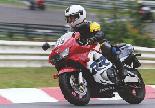 OK admit it. This was the bit you really wanted wasn't it? What's he got? Well
the first thing he's got is a history of serial motorcycle crashing. My
arms don't quite bend the way they should but if you want to track race
motorcycles for years that's just one of those things you have to get used too.
I don't do it now as the damage finally added up too far. This is my problem so
I cater for it. Oh, and before you ask, yes, it was worth
it.
OK admit it. This was the bit you really wanted wasn't it? What's he got? Well
the first thing he's got is a history of serial motorcycle crashing. My
arms don't quite bend the way they should but if you want to track race
motorcycles for years that's just one of those things you have to get used too.
I don't do it now as the damage finally added up too far. This is my problem so
I cater for it. Oh, and before you ask, yes, it was worth
it.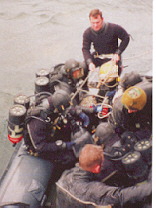 I am told the military used to use this position - the picture probably dates
from the late nineties. They took it further than I would though. As I
understand it the drill ran like this: No contents gauge but start with both
tanks full and one isolated. Breathe from one tank until the increasing
resistance tells you it is empty. Open the valve and equalise the two tanks
then shut the value off again. If you started at 200bar you are now at 100bar
in both. Again breathe it out and finally open the valve and this time leave it
open and ascend. You have 50bar across both the tanks, one quarter of the
initial supply. Why do this? Because in zero vis you can't see a gauge and zero
vis is not a reason not to dive. Could they do this if the valves were behind
their shoulder-blades? Some people might be able to but in the inverted
configuration I can reach both the valves that feed the regulators and right
round to the isolator in the middle if I need too.
I am told the military used to use this position - the picture probably dates
from the late nineties. They took it further than I would though. As I
understand it the drill ran like this: No contents gauge but start with both
tanks full and one isolated. Breathe from one tank until the increasing
resistance tells you it is empty. Open the valve and equalise the two tanks
then shut the value off again. If you started at 200bar you are now at 100bar
in both. Again breathe it out and finally open the valve and this time leave it
open and ascend. You have 50bar across both the tanks, one quarter of the
initial supply. Why do this? Because in zero vis you can't see a gauge and zero
vis is not a reason not to dive. Could they do this if the valves were behind
their shoulder-blades? Some people might be able to but in the inverted
configuration I can reach both the valves that feed the regulators and right
round to the isolator in the middle if I need too.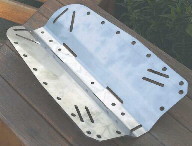 OK what tricks are needed for this system? The back plate is laser cut marine
grade stainless steel. It is my modification of a drawing supplied to me by
Chris Stephenson via the uk.rec.scuba newsgroup and it was originally drawn by
Roger Lacasse whom I have never met but thank. I changed the shape and the hole
configuration and added slots so I can add cam bands for single tanks or at
least my Autocad literate brother did. Somehow I seemed to end up copying it
for the rest of the group. If you want the drawings they are
here.
OK what tricks are needed for this system? The back plate is laser cut marine
grade stainless steel. It is my modification of a drawing supplied to me by
Chris Stephenson via the uk.rec.scuba newsgroup and it was originally drawn by
Roger Lacasse whom I have never met but thank. I changed the shape and the hole
configuration and added slots so I can add cam bands for single tanks or at
least my Autocad literate brother did. Somehow I seemed to end up copying it
for the rest of the group. If you want the drawings they are
here.| Is it easy to set up? Look at the pictures. Lay the tanks down with the bolts pointing up. The picture shows the Custom Divers tank protectors (Bull bars) on which the rig stands while you put it on. I also use screw in DIN valve protectors to keep the threads clean but I remove them totally and put them in the toolbox once the regs are fitted as they will either get lost, get entangled in something or, more likely, end up under the Bull Bars when I sit back down and get trashed. |  |
| Fit the regs and route the hoses. On the left (near side) is the primary reg, a longer than normal wing inflator running up between the tanks and a Scubapro SPG and depth gauge console. On the right the secondary reg feeds up between the tanks while the drysuit inflator and a second SPG are clipped together. The two SPGs end up clipped to the chest D-rings so they are quick and easy to see but the drysuit hose is only there to stop it getting lost and is unclipped as I put the rig on and I fit it to the Apeks swivelling injector. |  |
| Lay on the wing ensuring the two hoses are safely in the gap between the tanks so the backplate will trap them without pinching them. The DiveRite Classic, purchased without the harness, is very simple and tough as old boots. It has a fabric panel virtually the width of the backplate so it is unsuitable for a single cylinder rig but pretty much ideal for the twinset. I have kept the pull to dump that is hated by the purists as it is, I feel, a useful feature. The inflator will be passed through a bungie loop on the left chest D-ring to keep it in an obvious grab zone. |  |
| Then the backplate is fitted which is always rigged with the harness. Again I depart from the pure Hogarthian rig by fitting a pinch clip to the crotch strap. This makes dekitting to get back into a RIB much easier as I can let go the clip and hand off my weight belt more easily. Finally fit and gently hand tighten the wing nuts and stand the set up on the valve protector and put it on. I can now turn on the gas, check the isolator is open about three quarters of a turn. |  |
 Both the regs have longish (1.5m) hoses. The primary one loops forward from the
first stage behind my left hip, up my left side, back over my left shoulder,
round the back of my neck and over my right shoulder to my mouth. This is
copied from the Hogarthian system and this is the reg to donate to an OOA (out
of air) buddy. It is not as long as the classic 7 foot DIR hose which, starting
behind your shoulder, allows a buddy to precede you through confined tunnel to
do a shared air exit but I am not building a cave rig here. Wrecks may be
constricted but it is by bulkheads, the passageways are not the problem. In
fact in the few wrecks that are intact enough to enter the problem is normally
visibility not confined space and, anyway, the wrecks that really interest me
are not intact enough to enter in that sense. At five feet it is enough to save
you from completely being tied to one another's face as a normal octopus does
so you can deploy the blob and get up and out conveniently.
Both the regs have longish (1.5m) hoses. The primary one loops forward from the
first stage behind my left hip, up my left side, back over my left shoulder,
round the back of my neck and over my right shoulder to my mouth. This is
copied from the Hogarthian system and this is the reg to donate to an OOA (out
of air) buddy. It is not as long as the classic 7 foot DIR hose which, starting
behind your shoulder, allows a buddy to precede you through confined tunnel to
do a shared air exit but I am not building a cave rig here. Wrecks may be
constricted but it is by bulkheads, the passageways are not the problem. In
fact in the few wrecks that are intact enough to enter the problem is normally
visibility not confined space and, anyway, the wrecks that really interest me
are not intact enough to enter in that sense. At five feet it is enough to save
you from completely being tied to one another's face as a normal octopus does
so you can deploy the blob and get up and out conveniently.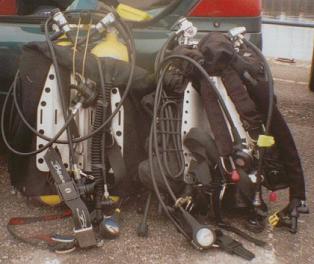 The harness and the backplate are, frankly, a straight copy of the Hogarthian
system including the crotch strap except that I added a a pinch clip in the
crotch strap to try and make the dekit operation for RIB diving more direct.
To make things clear the weight belt is in black and the harness in yellow and
red stripes so a buddy can tell them apart. Also one clip is left handed and
the other is right handed so I can tell them apart blind.
The harness and the backplate are, frankly, a straight copy of the Hogarthian
system including the crotch strap except that I added a a pinch clip in the
crotch strap to try and make the dekit operation for RIB diving more direct.
To make things clear the weight belt is in black and the harness in yellow and
red stripes so a buddy can tell them apart. Also one clip is left handed and
the other is right handed so I can tell them apart blind.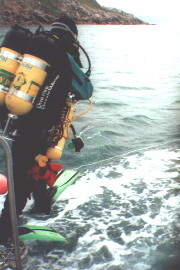 It's heavy. Maybe the 300 bar 10's were a mistake as I have 33Kgs of steel
on my back to give me the gas supply of twin 12s at 230bar. (Remember that due
to the Van de Waals forces you only get 20% more gas going to 300 bar from 230
rather than the 30% you expected on the ideal gas laws.) However what it does
do is reduce my weight belt so overall I am lighter than twin 12s as I displace
4 litres less water. Good news on a hard boat climbing the ladder but harder on
a RIB as you hand off less weight belt.
It's heavy. Maybe the 300 bar 10's were a mistake as I have 33Kgs of steel
on my back to give me the gas supply of twin 12s at 230bar. (Remember that due
to the Van de Waals forces you only get 20% more gas going to 300 bar from 230
rather than the 30% you expected on the ideal gas laws.) However what it does
do is reduce my weight belt so overall I am lighter than twin 12s as I displace
4 litres less water. Good news on a hard boat climbing the ladder but harder on
a RIB as you hand off less weight belt.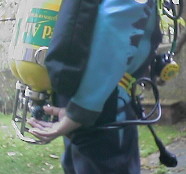
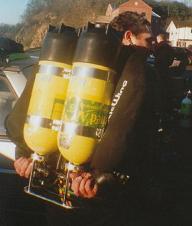 The long hose rig and donating the primary is simplicity itself. An OOA buddy
grabs and even when they jump me on a drill I've been diving long enough to be
annoyed rather than panicked. You just duck and the hose goes free and they
can breathe and get their act back together on a reg that they know is working
while I have the secondary just below my chin with the adjustments wound up
tight to stop it free flowing and I tested it in my pre-dive checks. If it has
a problem I have not just done an OOA fast swim so I can take time to fix it or
at least survive while my buddy gets enough of my gas into him to be able to
buddy breathe with some self control.
The long hose rig and donating the primary is simplicity itself. An OOA buddy
grabs and even when they jump me on a drill I've been diving long enough to be
annoyed rather than panicked. You just duck and the hose goes free and they
can breathe and get their act back together on a reg that they know is working
while I have the secondary just below my chin with the adjustments wound up
tight to stop it free flowing and I tested it in my pre-dive checks. If it has
a problem I have not just done an OOA fast swim so I can take time to fix it or
at least survive while my buddy gets enough of my gas into him to be able to
buddy breathe with some self control.